
The Frans Hals Museum is a museum in the North Holland city of Haarlem, the Netherlands, founded in 1862, known as the Art Museum of Haarlem. Its collection is based on the city's own rich collection, built up from the 16th century onwards. The museum owns hundreds of paintings, including more than a dozen by Frans Hals, to whom the museum owes its name. The Frans Hals Museum has two historic locations in Haarlem city centre: the main location on Groot Heiligland and Location Hal on Grote Markt, composed of the adjacent 17th-century Vleeshal and 19th-century Verweyhal. On Groot Heiligland is the 17th-century Oudemannenhuis with regent's rooms. It houses the famous paintings by Frans Hals and other ancient, modern and contemporary art, as well as the museum café. Location Hal regularly hosts exhibitions of modern and contemporary art.
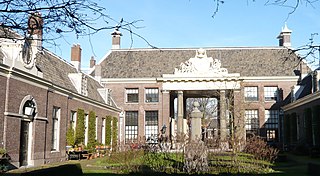
The Teylershofje is a hofje in Haarlem, Netherlands with 24 houses.

Haarlem is one of the cities in the Netherlands that has a number of hofjes. Some of them are still in use with boards of regents. Many of these are members of the Stichting Haarlemse Hofjes. The word 'hofje' just means small garden, because the hofjes are generally small houses grouped around a community kitchen garden with a water pump. Often they were attached to a larger field for bleaching linen or growing orchards, but today those fields have been long used for city expansion and only the central gardens can still be seen.

The Wijnbergshofje is a hofje in Haarlem, Netherlands, on the Barrevoetstraat.

The Zuiderhofje is a hofje in Haarlem, Netherlands.

Villa Welgelegen is a historical building in Haarlem, the Netherlands, which currently houses the offices of the provincial executives of North Holland. Located at the north end of a public park in the city, it is an example of neoclassical architecture, designed by Abraham van der Hart and unusual for its style in the Netherlands.
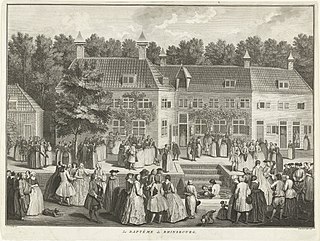
In Christian history, the Collegiants, also called Collegians, were an association, founded in 1619 among the Arminians and Anabaptists in Holland. They were so called because of their colleges (meetings) held the first Sunday of each month, at which everyone had the same liberty of expounding the scripture and praying.

Pieter Teyler van der Hulst was a wealthy Dutch Mennonite merchant and banker, who died childless, leaving a legacy of two million florins to the pursuit of religion, arts and science in his hometown, that led to the formation of Teyler's Museum. This was not the value of his entire estate. He also founded Teylers Hofje in his name, and made important donations to individuals in the Mennonite community.

The Vrouwe- en Antonie Gasthuis is a hofje on the Klein Heiligland 64a in Haarlem, Netherlands. It is open on weekdays from 10-17.00.
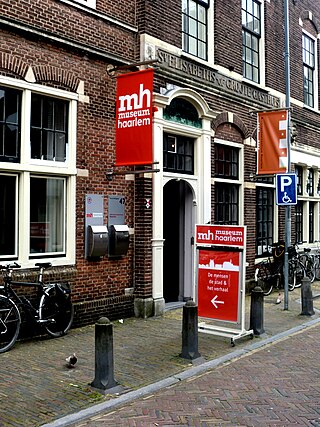
Museum Haarlem is a city museum on Groot Heiligland 47, Haarlem, Netherlands, located across the street from the Frans Hals Museum. It shares its front door with the ABC Architectuurcentrum Haarlem, which is located next door. The museum is devoted to presenting and preserving the cultural history of Haarlem and the surrounding region.

Wybrand Hendriks was a Dutch painter, primarily known for his portraits, and the concierge of the Teylers Museum.

Stichting Weeshuis Sri Lanka is a Dutch NGO-foundation that after the disastrous tsunami of December 26, 2004 was founded to help the children that became orphans.

The Fundatiehuis is the former family home of Pieter Teyler van der Hulst on the Damstraat 21 in Haarlem, Netherlands. After his death it became the seat of the Teylers Stichting and through its front door, visitors could reach the Oval room.

Cornelis van Noorde was an 18th-century landscape painter and drawer from the Dutch Republic.

Abraham de Vries was a Dutch Mennonite minister, author on literature and member of several societies, mainly literary ones.
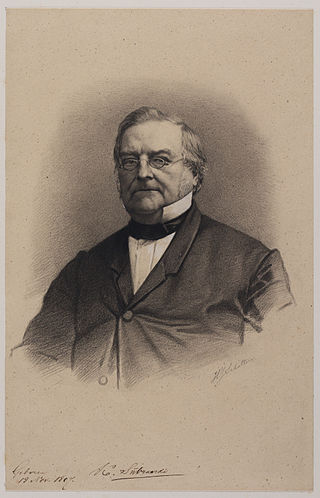
Klaas Sybrandi, also spelled as Sijbrandi, was a Dutch Mennonite minister, author and translator who was involved with several societies and foundations.

The Doopsgezinde Weeshuis is a former orphanage in Haarlem. The complex was designed by A. van der Linden to replace the old orphanage located at the Klein Heiligland 58, which had been in use since 1634.
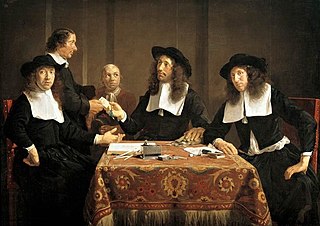
A regents group portrait, is a group portrait of the board of trustees, called regents or regentesses, of a charitable organization or guild. This type of group portrait was popular in Dutch Golden Age painting during the 17th century, and in the 18th century. They were intended to be hung in the regentenkamer, the regents' meeting room, or another prominent location in the institution.

The Holy Spirit Orphanage was an orphanage in the city of Leiden in the Netherlands. It is a Rijksmonument located on Hooglandse Kerkgracht 17B.






















